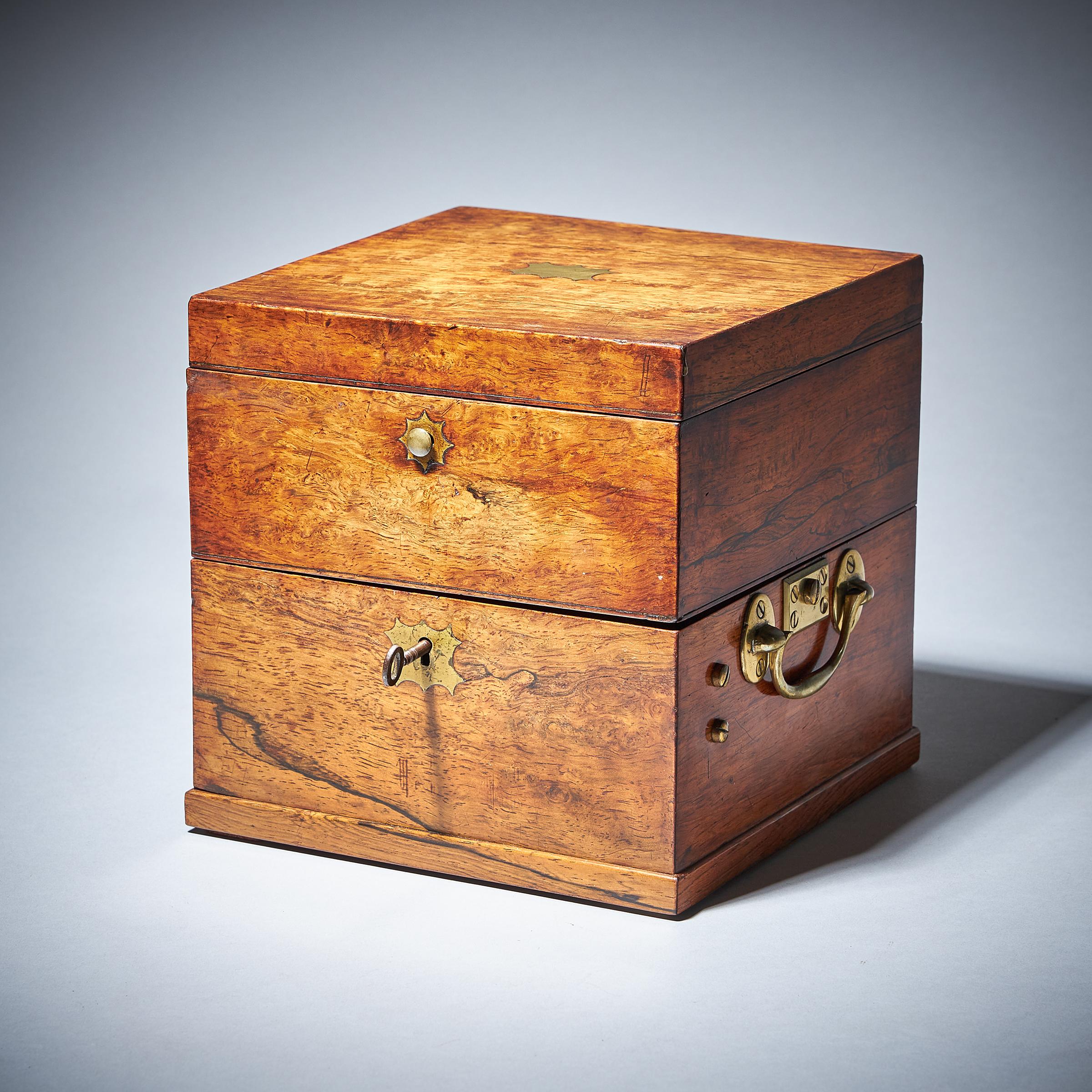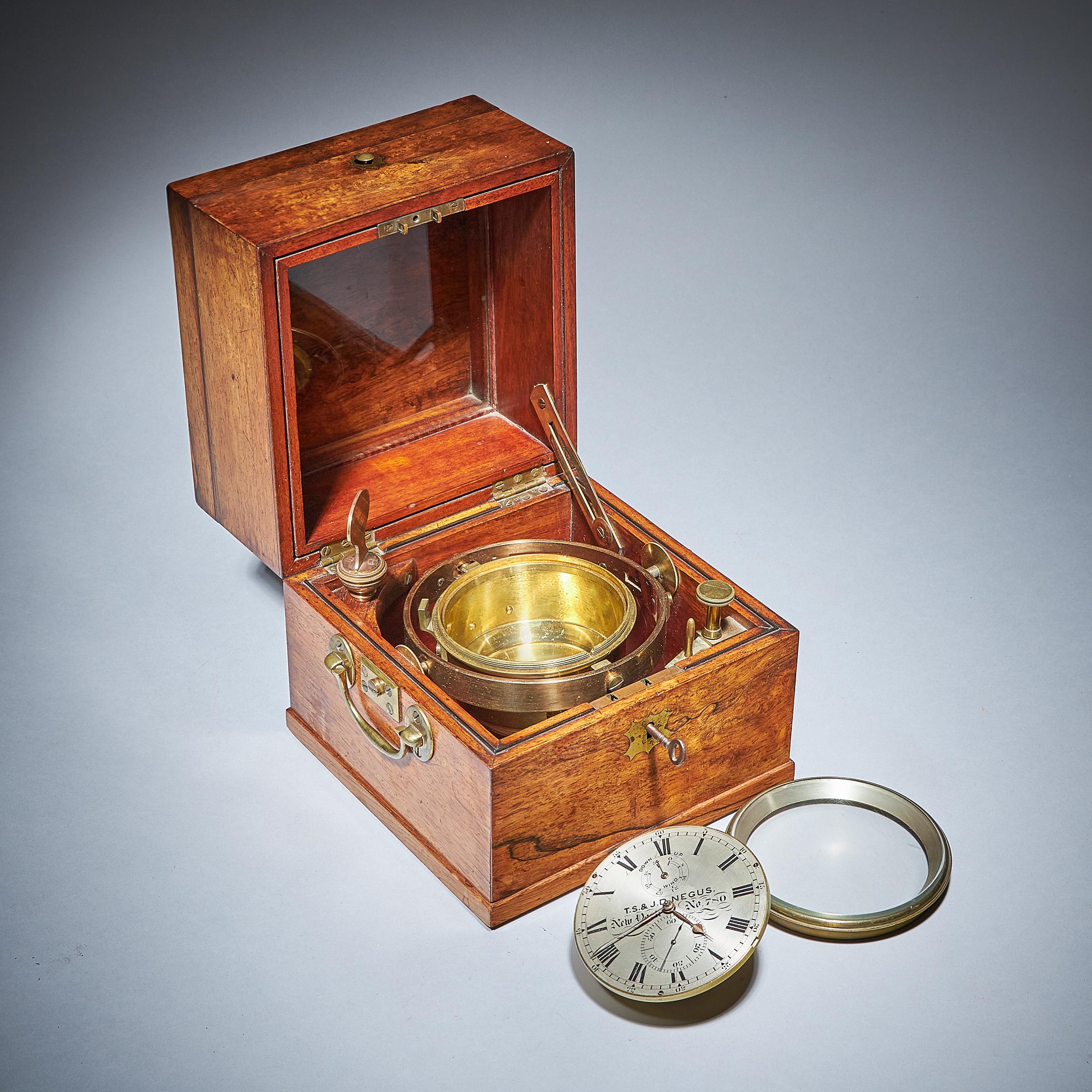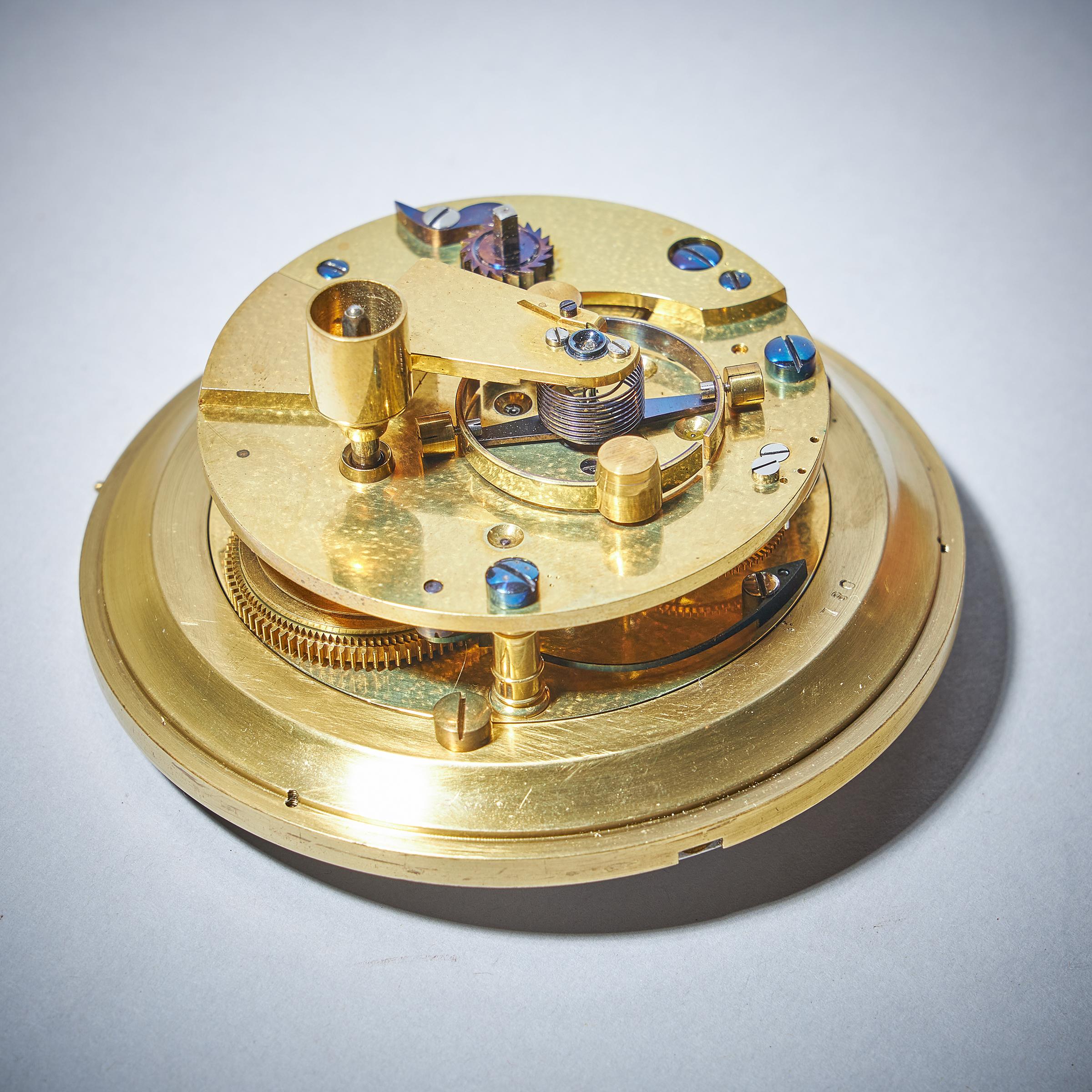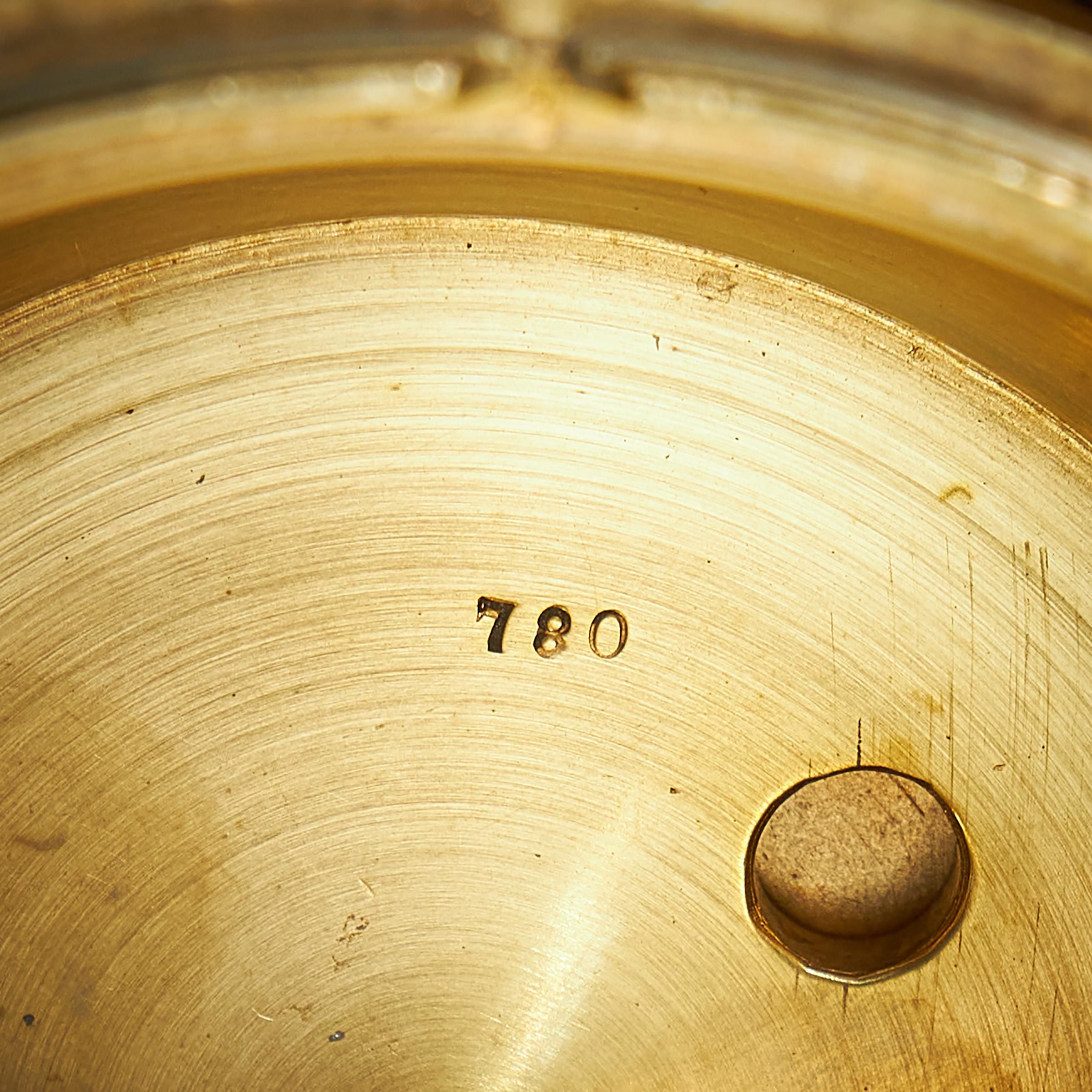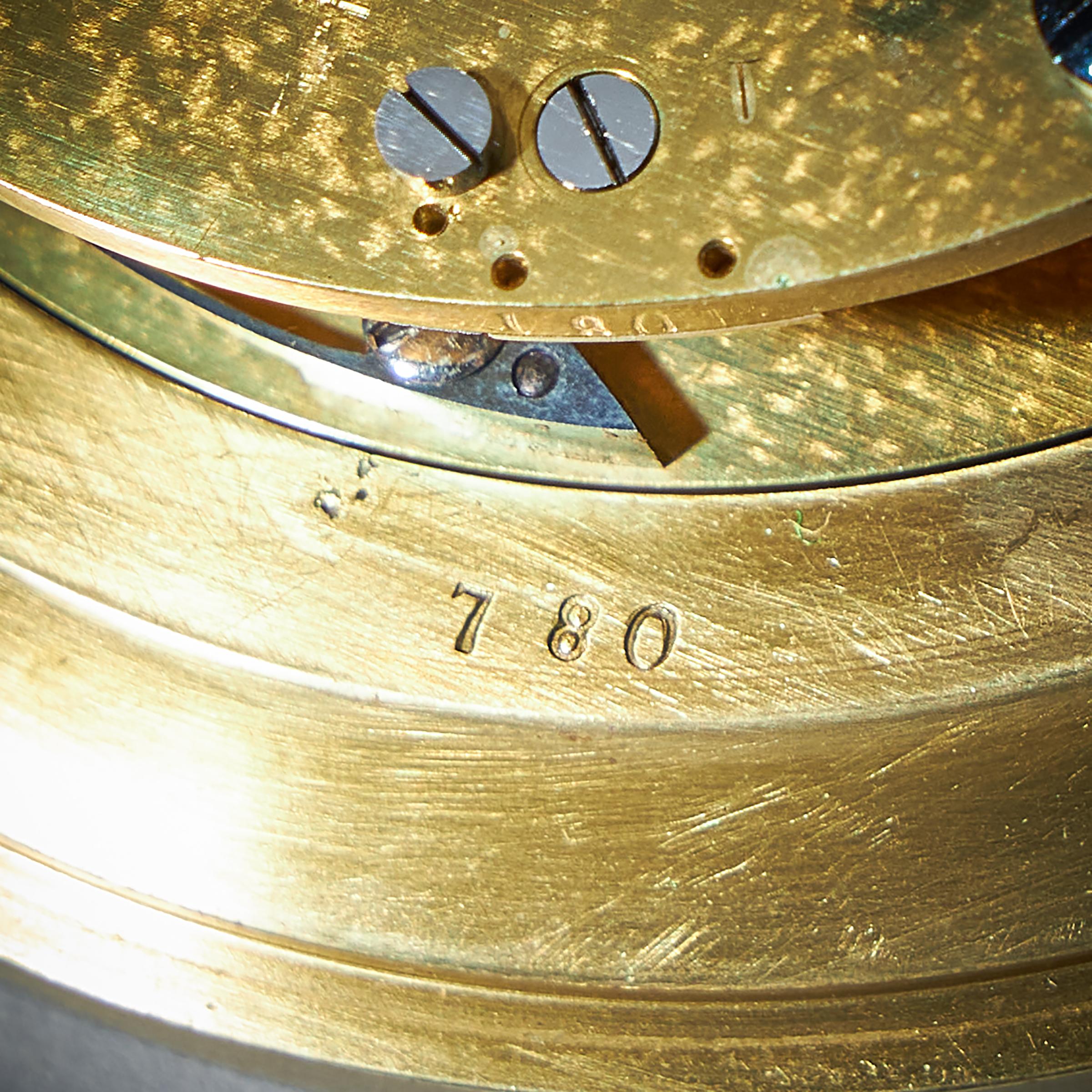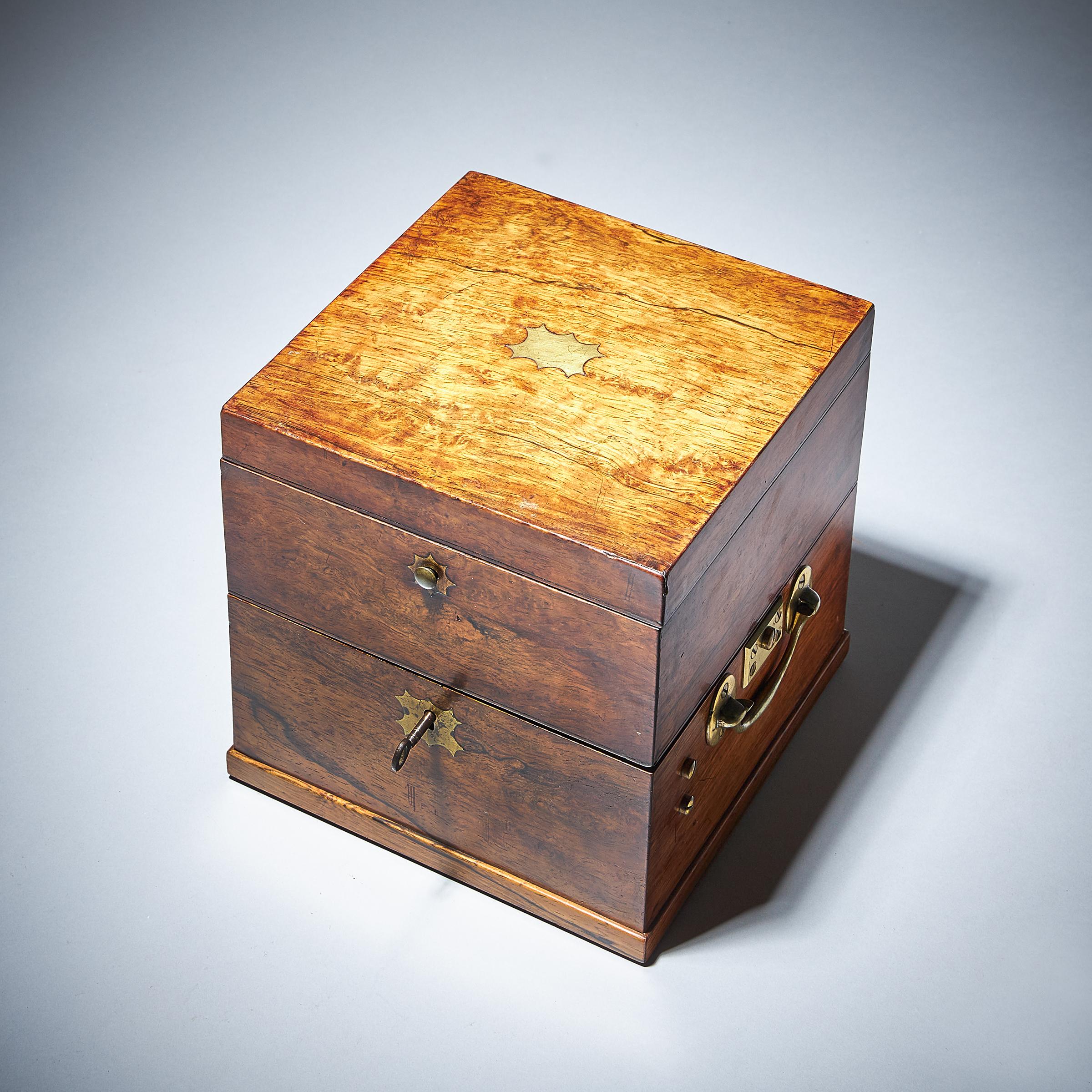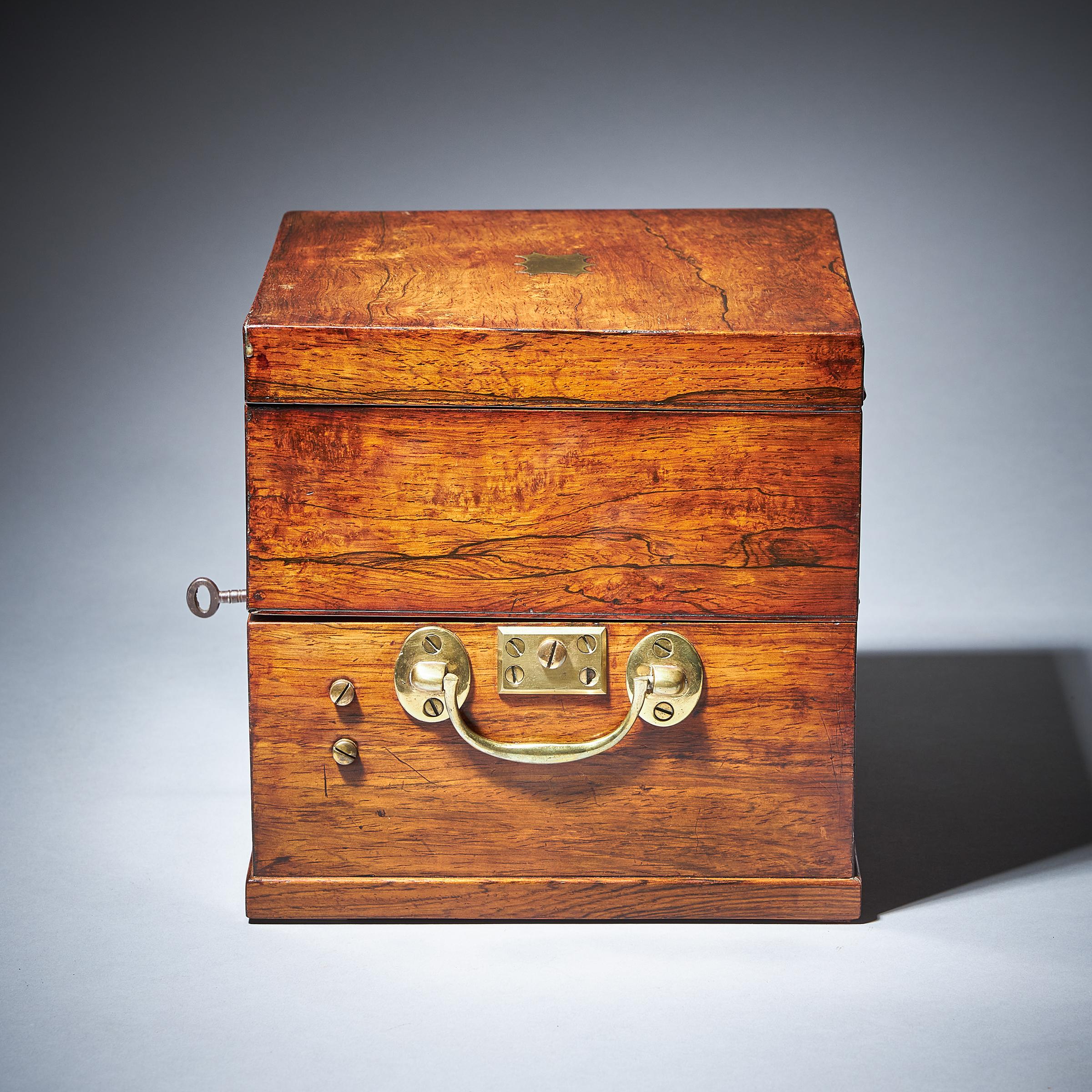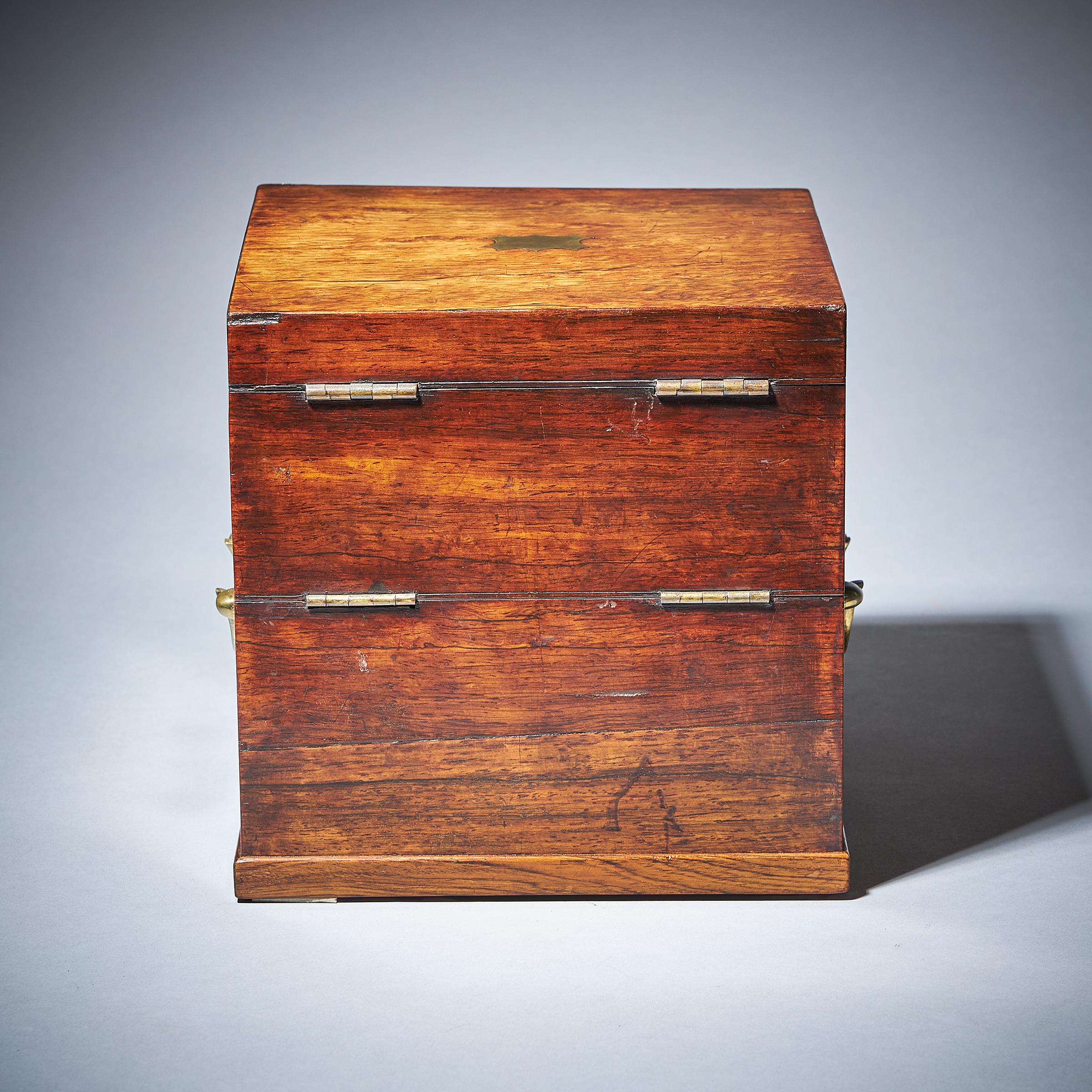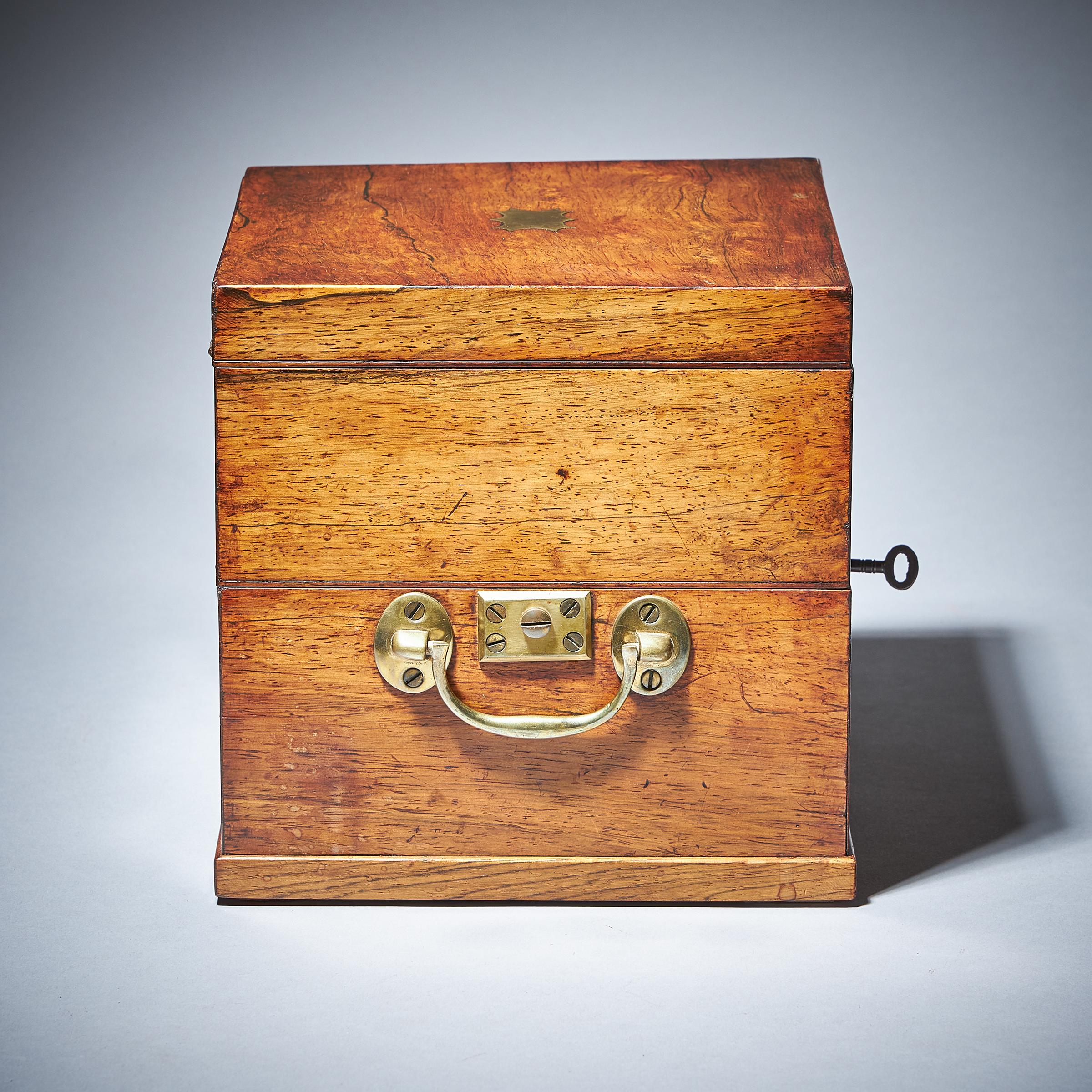Fine American Two Day Marine Chronometer, Signed T. S & J. D Negus New York
Sold
Request Information
Follow Us
Fine American Two Day Marine Chronometer, Signed T. S & J. D Negus New York
A Classic beautifully produced mid-19th century American chronometer in a three-tier rosewood case, made c. 1850-60. The typically constructed case consists of a lower and glazed upper part, as well as an observation lid. The lower part has two drop handles to the sides, while the front has a lock and key with an inlaid brass escutcheon. In the front of the upper part, there is a brass button to lock the observation lid. The movement is situated in a gimballed brass bowl, which can be secured for transport purposes by a turnable handle in the bottom right corner of the case. The 4” silvered dial is protected by a flat bevelled glass set in a bezel, screwed to the bowl.
The makers have signed and numbered the chronometer on the silvered dial in the following manner:
T. S & J. D NEGUS
NEW YORK No. 780
The time is indicated by a fine pair of gilt brass hands on the silvered dial with a Roman chaptering, Arabic five-minute and minute divisions
The seconds are indicated by a blued-steel hand on a separate chapter ring below the middle with Arabic ten-second, five-second and second divisions. Below the XII is an up-and-down dial 0 – 56 (hours).
The two-day duration movement is constructed between two circular plates and is driven by a spring in a spring barrel via a chain fusee. It has a so-called Earnshaw spring detent escapement with a compensated balance and helical spring. The chronometer is wound by a special key with a ratchet to prevent winding the clock in the wrong direction. The key can be stored in a hole in the left top corner of the case. The winding hole is covered by a sprung shutter.
The makers:
T.S. and J.D. Negus were British immigrants. In 1848 Thomas Steward Negus and his brother John Davidson Negus founded the firm of T.S. & J.D. Negus, which manufactured and sold maritime chronometers and nautical instruments at 140 Water Street, New York City near the East River. The firm made chronometers for the United States Navy as well as shipmasters and yachtsmen. Their instruments were among the best manufactured in the country. The firm traded as T. S. Negus & Co. in 1864 and as T.S. & J.D. Negus in 1869. The firm was described as “probably the most prolific American chronometer manufacturer” up through the first quarter of the 20th century. From 1886 to 1887, in competitive trials of chronometers at the United States Naval Observatory, located in Washington, D. C., their chronometers passed first place in a list of 45 chronometers submitted for testing. Sea captains came to the shop to purchase and have their chronometers tested, rated and certified.
Thomas’s brother, John D. Negus, died on September 26, 1890. John’s son, John S. Negus continued in the firm under the T.S. & J.D. Negus name until his death on July 14, 1944. His son, John C. Negus, from Brooklyn, continued with the firm as senior partner until his death on December 15, 1961. His son, John S. Negus II, ran the family business until his death in 1963. On March 8, 1964, the New York Daily News announced that John C. Negus II bequeathed to the museum of the City of New York a 19th-century ship’s binnacle that the Negus firm made.
Condition
Good. Wear consistent with age and use. Fantastic condition throughout, in perfect order.
Dimensions
Height: 7.09 in. (18 cm)
Diameter: 7.09 in. (18 cm)
Literature
Tony Mercer, chronometer makers of the world, p. 195
Jonathan Betts, marine chronometers at Greenwich, Oxford, 2017.
PREVIOUSLY SOLD
No Results Found
The page you requested could not be found. Try refining your search, or use the navigation above to locate the post.
No Results Found
The page you requested could not be found. Try refining your search, or use the navigation above to locate the post.
YOU MAY ALSO LIKE
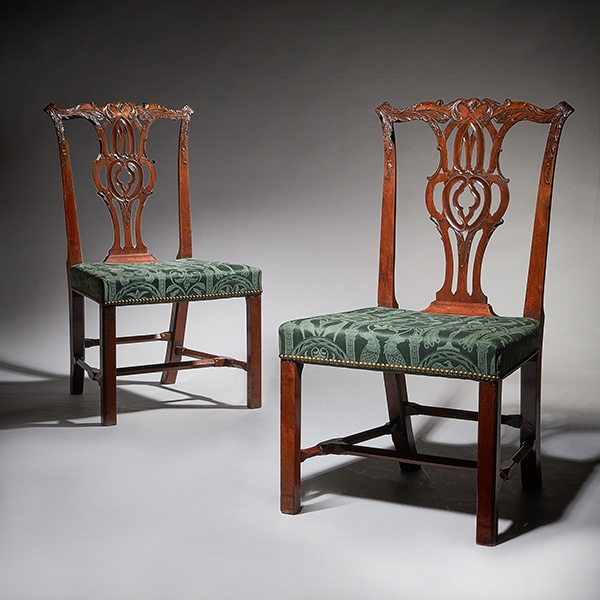
Pair of 18th Century George III Carved Mahogany Chippendale Chairs
Pair of 18th Century George III Carved Mahogany Chippendale Chairs £8,900Follow UsPair of 18th Century George III Carved Mahogany Chippendale Chairs A simply superb pair of carved George III mahogany chairs, C.1770. Condition Good. Wear...
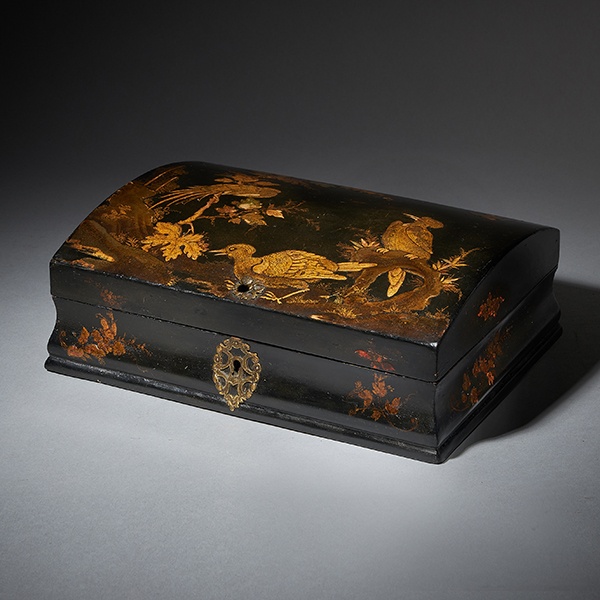
18th Century Japanned Chinoiserie Dome-Topped Box, Circa 1715-1725
18th Century Japanned Chinoiserie Dome-Topped Box, Circa 1715-1725 £3,800Follow Us18th Century Japanned Chinoiserie Dome-Topped Box, Circa 1715-1725 Early 18th century George I Japanned Chinoiserie dome-topped box, Circa 1715-1725. England or...
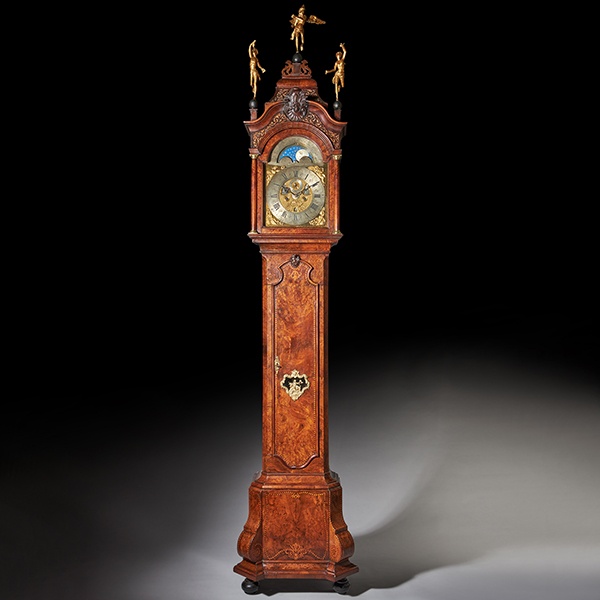
Magnificent 18th Century Striking Dutch Amsterdam Burl Walnut Longcase Clock
Magnificent 18th Century Striking Dutch Amsterdam Burl Walnut Longcase Clock £26,000Follow UsMagnificent 18th Century Striking Dutch Amsterdam Burl Walnut Longcase Clock An impressive Dutch longcase clock with a burr walnut veneered oak case,...

18th Century George III Mahogany Wine Cooler or Cellarette
18th Century George III Mahogany Wine Cooler or Cellarette £4,600Follow Us18th Century George III Mahogany Wine Cooler or Cellarette A fine and well-figured George III mahogany hexagonal wine cooler or cellarette on the original stand, C....

Striking 19th Century Carriage Clock with a Gilt-Brass Corniche Case by Grohé
Striking 19th Century Carriage Clock with a Gilt-Brass Corniche Case by Grohé £3,995 Follow UsStriking 19th Century Carriage Clock with a Gilt-Brass Corniche Case by Grohé Striking carriage clock with a gilt-brass corniche case by Grohé,...
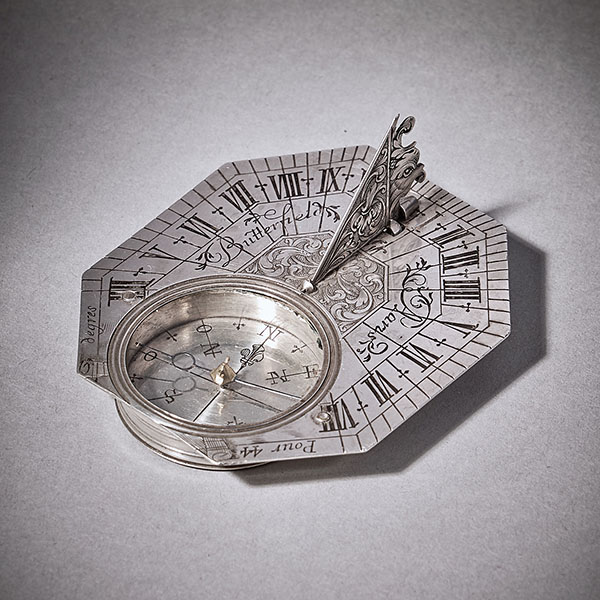
Rare Silver Pocket Sundial and Compass by Michael Butterfield, Paris, circa 1700
Rare Silver Pocket Sundial and Compass by Michael Butterfield, Paris, circa 1700 £4,900 Follow UsRare Silver Pocket Sundial and Compass by Michael Butterfield, Paris, circa 1700 A beautiful, rare solid silver Anglo-French octagonal pocket...

Pair of 18th Century George III Carved Mahogany Chippendale Chairs
Pair of 18th Century George III Carved Mahogany Chippendale Chairs £8,900Follow UsPair of 18th Century George III Carved Mahogany Chippendale Chairs A simply superb pair of carved George III mahogany chairs, C.1770. Condition Good. Wear...

18th Century Japanned Chinoiserie Dome-Topped Box, Circa 1715-1725
18th Century Japanned Chinoiserie Dome-Topped Box, Circa 1715-1725 £3,800Follow Us18th Century Japanned Chinoiserie Dome-Topped Box, Circa 1715-1725 Early 18th century George I Japanned Chinoiserie dome-topped box, Circa 1715-1725. England or...

Magnificent 18th Century Striking Dutch Amsterdam Burl Walnut Longcase Clock
Magnificent 18th Century Striking Dutch Amsterdam Burl Walnut Longcase Clock £26,000Follow UsMagnificent 18th Century Striking Dutch Amsterdam Burl Walnut Longcase Clock An impressive Dutch longcase clock with a burr walnut veneered oak case,...

18th Century George III Mahogany Wine Cooler or Cellarette
18th Century George III Mahogany Wine Cooler or Cellarette £4,600Follow Us18th Century George III Mahogany Wine Cooler or Cellarette A fine and well-figured George III mahogany hexagonal wine cooler or cellarette on the original stand, C....

Striking 19th Century Carriage Clock with a Gilt-Brass Corniche Case by Grohé
Striking 19th Century Carriage Clock with a Gilt-Brass Corniche Case by Grohé £3,995 Follow UsStriking 19th Century Carriage Clock with a Gilt-Brass Corniche Case by Grohé Striking carriage clock with a gilt-brass corniche case by Grohé,...

Rare Silver Pocket Sundial and Compass by Michael Butterfield, Paris, circa 1700
Rare Silver Pocket Sundial and Compass by Michael Butterfield, Paris, circa 1700 £4,900 Follow UsRare Silver Pocket Sundial and Compass by Michael Butterfield, Paris, circa 1700 A beautiful, rare solid silver Anglo-French octagonal pocket...




